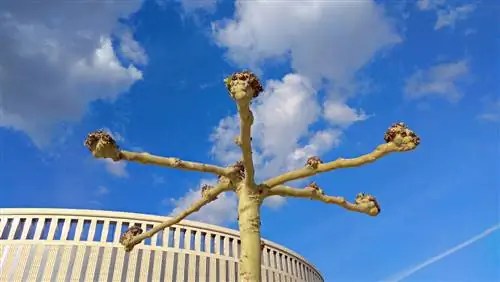- Author admin [email protected].
- Public 2023-12-16 16:46.
- Last modified 2025-01-23 11:22.
Our climate is considered temperate and has no notable extremes. But during their long life, plane trees will have to experience one or two dry periods. Will they survive this unscathed or will they leave any traces? And is there anything the owner can do?

How do plane trees cope with drought?
Plane trees are heat and drought tolerant thanks to their cardiac root system, which extends in depth and width. However, young and newly planted plane trees require additional watering. Leaves that hang weakly indicate a lack of water.
Plane trees cope well with drought
Plane trees like moist soil, but they are also heat and drought tolerant. As a so-called heart rooter, the plane tree has a root system that goes both deep and wide. This means their roots can still find water even in hot summers.
Support is only needed for freshly planted or young specimens whose roots have not yet fully developed. Also water older trees if it is hot for many days or even weeks without rain.
Drought can promote disease
If the weather is dry and hot, middle-aged plane trees in particular can suffer from massaria disease. In the worst case, branches can rot and break. This danger must be recognized in good time and averted by targeted removal of the branches. However, you have to look closely here, because many branches are affected on the top side, which is difficult to see. These are other signs that indicate this fungal disease:
- reddish to pink colored bark parts
- the following year with dark fungal spores
- dying and falling bark
- the foliage is becoming thinner and thinner
Cracked, peeling bark
In hot summers, it is noticeable that the bark of the plane tree splits open to a large extent and detaches itself from the tree trunk or branches. Accompanying this, loud bursting noises can also be heard. Are these actually the consequences of drought, as is often assumed?
Even if it looks like it at first glance, drought is not the cause of plane trees losing their bark. This is a natural process with the plane tree. While the tree grows up to 70 cm per year, the bark does not grow. The trunk increases in size and at some point “bursts” the tight corset of bark.
Signs of water shortage
The easiest way to tell whether a plane tree is suffering acutely from drought is to look at its leaves. They first lose moisture and then hang down weakly. At that point at the latest, such a suffering tree needs to be watered extensively.






